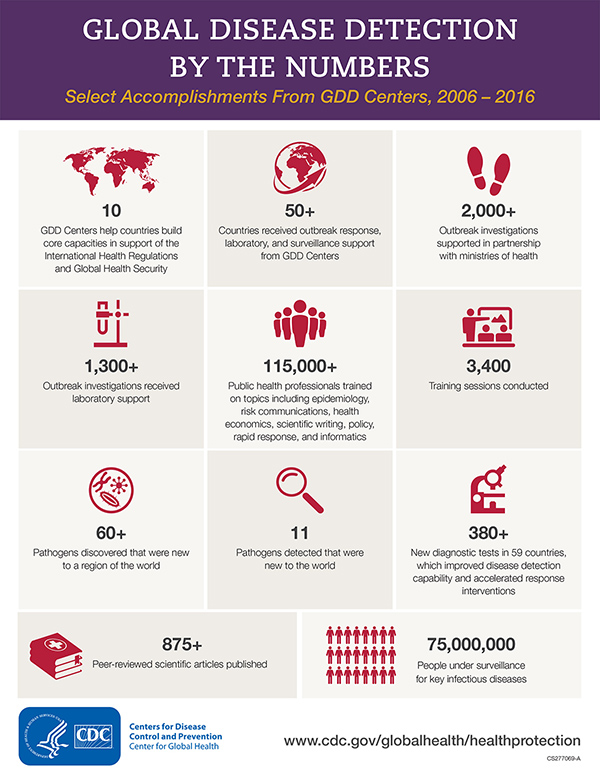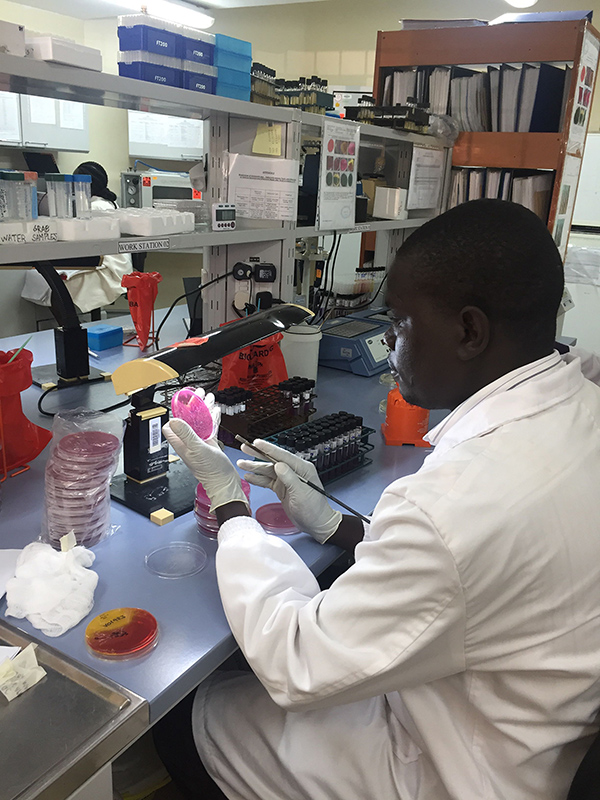What’s Causing Outbreaks? Kenya’s Laboratories are Giving the Answers

Diagnostic laboratories are essential to identifying the specific pathogen (bacteria, virus, or parasite) behind an illness. Different pathogens may cause illnesses with similar sets of signs and symptoms. Without laboratory testing, public health officials may attribute the cause of an outbreak to the wrong pathogen, and either underestimate or overestimate the burden of a disease outbreak. This can lead to actions that have serious consequences for the health of a population—a slow public health response, a misdirected response, or even missing an easily preventable disease and therefore unnecessarily exposing people to illness.
As the world becomes more interconnected, we are likely to experience an increase in emerging and re-emerging infectious diseases like Middle East Respiratory Syndrome Coronavirus (MERS-CoV), Ebola, and Zika. In these times, it is critical that countries develop high-quality public health laboratory systems that can rapidly and accurately detect and report health threats and thereby ensure global health security. If not quickly contained, many of these diseases can easily spread nationally and internationally. As a result, diseases can emerge in places where they were previously eradicated or never circulated, setting public health efforts back years or decades.
Taking the guesswork out of outbreaks

In 2007, CDC, in partnership with Bill and Melinda Gates Foundation and the CDC Foundation and other organizations, established a program in Kenya that would improve their ability to accurately diagnose the cause of illnesses. CDC Kenya’s Diagnostics and Laboratory Systems Program (DLSP) has since supported the Kenya Medical Research Institute (KEMRI) in testing for over 50 pathogens such as Ebola virus, rabies virus, Vibrio cholerae, dengue virus, Neisseria meningitidis, and Chikungunya virus.
DLSP supports three KEMRI laboratories strategically placed in urban and rural areas of Kenya. In Kibera, one of the largest informal settlements in the world, the cell culture and microbiology laboratory is an integral part of a population-based disease surveillance program set up by CDC, KEMRI, and Carolina for Kibera, a non-governmental organization. This initiative monitors common diseases including measles, influenza, and diarrheal and waterborne diseases caused by Salmonella Typhi and Shigella. Understanding these diseases allows for evidence-based interventions such as vaccinations or improved sanitation in a community.
The CDC Kenya supported facility in Kisumu houses zoonotic, respiratory, and enteric laboratories. In the Nairobi laboratory, technicians use the Taqman Array Card (TAC), a technology to detect multiple bacteria or viruses in a single sample. This laboratory also uses state-of-the-art Next Generation Sequencing (NGS) to help monitor for changes in the genetic sequences of bacteria and viruses. KEMRI also uses the NGS technology and molecular diagnostic techniques to identify antimicrobial resistant pathogens.
Improving KEMRI’s laboratory diagnostic capabilities

KEMRI’s testing capabilities have steadily increased over the years because of CDC Kenya support. In 2007, the laboratory could test for 9 viruses; by end of 2016, that capacity had increased to more than 50 viruses. Similarly, diagnostic testing for bacterial pathogens increased during the same period from 19 to more than 70.
In 2014, CDC’s Global Disease Detection (GDD) Regional Center in Kenya responded to 57 outbreaks, of which 51 received laboratory support and 18 yielded a confirmed laboratory diagnosis which identified the pathogen cause, including Neisseria meningitides, and ceftriaxone-resistant Salmonella enterica. Similarly, in 2016, more than 50% of the 27 outbreak responses had a laboratory diagnosis which identified the pathogen cause including influenza virus, Vibrio cholerae, hepatitis A virus, Chikungunya virus, and dengue virus.
CDC Kenya has also enhanced diagnostic laboratory capabilities in Kenya Ministry of Health (MoH) public health laboratories, though the provision of modern equipment in molecular diagnostics, virus culture, and antimicrobial susceptibility testing. CDC Kenya provides basic and advanced technical training to laboratory technicians and carries out proficiency testing to ensure the laboratories achieve high quality standards. In addition, CDC Kenya provides consumables to the county referral hospitals under the MoH to enable accurate and timely detection and reporting of disease outbreaks. These activities followed an assessment of the MoH national laboratory systems.
As clearly demonstrated in Kenya, laboratories play a critical role in detecting and informing the response to public health threats and developing solutions to detect outbreaks quickly to help prevent them from spreading. Since 2005, 10 Global Disease Detection Centers have discovered 12 pathogens that were identified for the first time anywhere in the world. They have enhanced laboratory diagnostic capacity in nearly 400 laboratory facilities and participated in the response to over 2,000 disease outbreaks and other emergencies since 2007, helping make the world safer, healthier, and more secure.